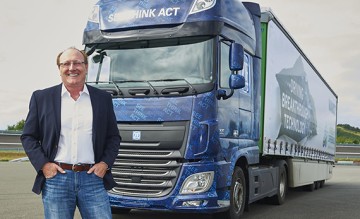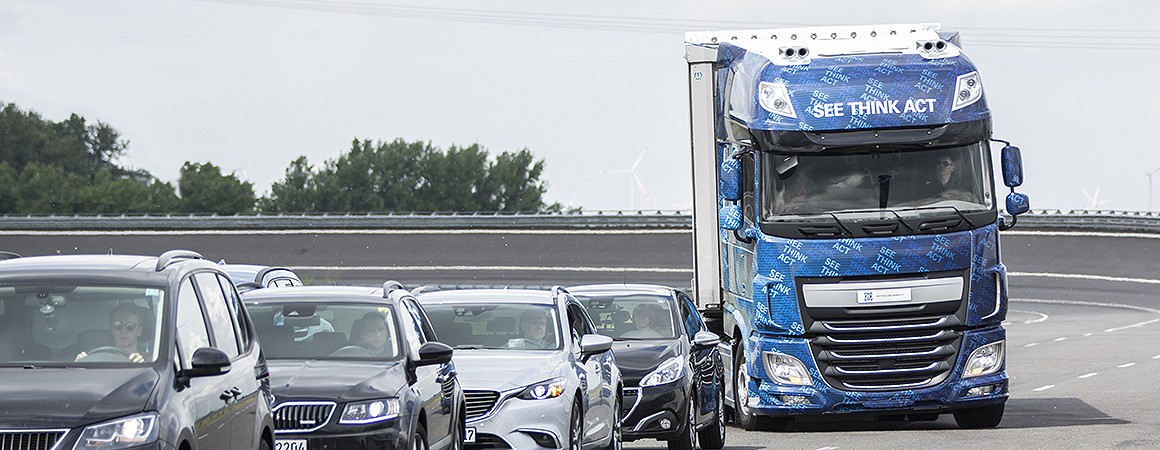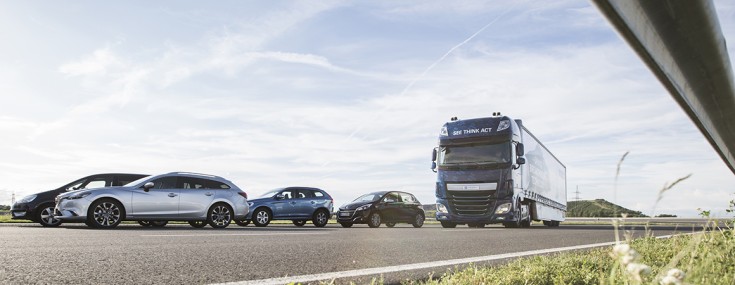The threatening image of the truck in the rear-view mirror looms ever larger. Can he see me? Will he stop in time? What if he doesn’t? Most people who have driven on highways or freeways will have experienced those anxious seconds of waiting as the last driver in a long line of vehicles watches a large truck approaching from behind at full speed.
Usually it all ends well, even if the truck driver’s attention is briefly distracted. After all, most modern trucks are fitted with a powerful Advanced Emergency Braking System (AEBS), as well as the ubiquitous Electronic Stability Control (ESC). Working automatically and in unison, these systems are capable of bringing even a 40-ton truck to a safe standstill while ensuring that it doesn’t swerve. Even so, too frequently for comfort, such everyday situations do still end in disaster. Increasingly, rear-end shunts are becoming the most common type of accident caused by trucks and they can result in serious injuries, or even fatalities. Now, with the world’s first Evasive Maneuver Assist (EMA) system for trucks, ZF and project partner Wabco have invented a feature that can help prevent this type of crash more effectively than any previous system.
Features for more Safety
EMA is one of the three new safety and comfort assistants for commercial vehicles that ZF will be presenting at this year’s IAA International Motor Show. “When it comes to developing vehicles that can see, think and act, we’re now the go-to partner for our customers. We’re using our strength in advanced technology to help make mobility safer and more efficient, boost automated driving and bring the ‘Toward Zero’ vision – meaning zero road fatalities – closer to reality” says ZF Board member Peter Lake.

A change of scene: rounding a corner into the straight, test driver Andreas Arnegger steers the ZF Innovation Truck 2016 toward a line of stationary vehicles – a typical traffic jam – at around 50 mph, the statutory speed limit for heavy trucks in Germany. Rain has made the road wet enough for aquaplaning to be a serious risk. In such extreme conditions, explains ZF project manager Sven Gohl, standard braking distances can be inadequate, even for EABS systems. Similar situations occur when obstacles are hidden around blind corners or over blind summits, when vehicles suddenly cut across lanes, or when roads are slippery with ice or snow.
Systems working in perfect harmony
In the cab, Arnegger deliberately ignores the first wave of audible and visual AEBS warning signals. Only when the truck has already started to brake by itself and the hazard has escalated to the highest level does he briefly pull on the steering wheel, activating the EMA feature in the process. The test driver immediately takes his hands off the steering wheel again, passing control of the truck over to the combined intelligence of the environmental sensors, braking system and ZF’s electrohydraulic ReAX power steering. And as anticipated, the ZF Innovation Truck steers itself into the empty adjacent lane; the rollover protection feature helps to ensure that the trailer stays in line. At the same time, the truck rapidly and purposefully decelerates. The 40-ton monster comes to a complete standstill about one and a half car lengths from the rear of the traffic jam. Even under full braking, if the truck had not simultaneously carried out this evasive maneuver, it would have crashed into the vehicle at the rear of the line at around 10 mph, releasing the same amount of energy as an average-sized family sedan traveling at 50 mph.
High-quality system
Happily, there was never any real danger here. ZF tests out new safety features on a private test circuit, with the help of professional drivers. One of them is Ellen Lohr, the first and only woman to win a German Touring Car Masters (DTM) race, nine-time participant in the Dakar Rally and, since 2013, a regular competitor in the European Truck Racing Championship. She is impressed by the evasive maneuver: “Inside the truck, you’re thrown around in your seatbelt and against the sides of your seat, but from outside, the semi-automatic swerve looks totally unspectacular and all this points to a very high-quality system. I wouldn’t have been able to spontaneously perform such a demanding maneuver with that degree of precision” she adds.

